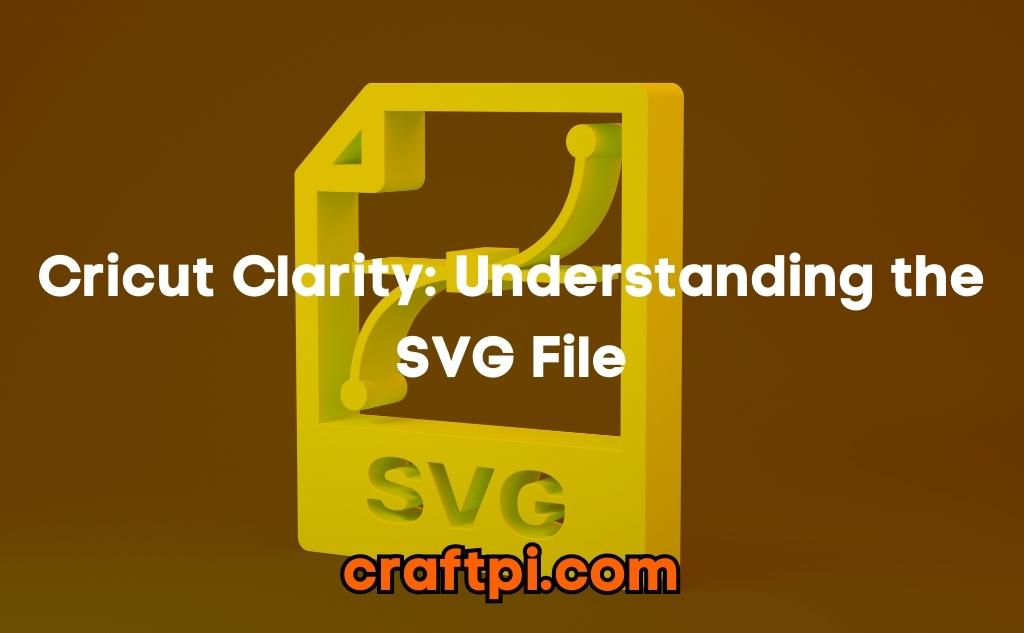Are you new to using SVG files with your Cricut machine? Or are you looking to maximize the potential of SVG files for your crafting projects? In this comprehensive guide, we will walk you through the ins and outs of SVG files and how they can enhance your Cricut experience. From understanding the structure of an SVG file to optimizing it for Cricut, we’ll cover everything you need to know. We’ll also explore advanced features and provide tips for troubleshooting common issues. By the end of this post, you’ll be equipped with the knowledge and tools to make the most out of SVG files with your Cricut.
What Is An Svg File?
What Is An SVG File?
SVG stands for Scalable Vector Graphics. It is a file format commonly used for vector graphics on the web. Unlike raster images that are composed of pixels, SVG files are made up of mathematically defined shapes and lines. This means that SVG files can be scaled up or down without losing any quality, making them ideal for both small icons and large images.
SVG files can be created and edited using various software programs such as Adobe Illustrator, Inkscape, and CorelDRAW. They are written in XML markup language, which allows designers to specify the properties and attributes of each element in the graphic. This makes SVG files highly customizable and easy to manipulate.
One of the main advantages of SVG files is their compatibility with different devices and browsers. Since SVG files are based on XML, they can be displayed on any modern web browser, regardless of the device or operating system. This makes SVG files a versatile choice for web designers and developers.

Why Should You Use Svg Files With Cricut?
SVG files, or Scalable Vector Graphics files, have become increasingly popular in the world of crafting and design. Many artists and creators now rely on SVG files to create stunning and intricate designs using cutting machines like Cricut. But what exactly is an SVG file, and why should you consider using it with Cricut? In this blog post, we will explore the benefits and advantages of using SVG files with Cricut and how they can enhance your crafting experience.
SVG files are graphic files that use XML-based markup language to describe two-dimensional vector graphics. Unlike raster images or bitmap graphics, which are made up of pixels, SVG files are made up of mathematical formulas and lines, making them scalable without losing any quality. This means that SVG files can be resized and adjusted to any size without pixelation or distortion, making them ideal for creating high-resolution designs for Cricut projects.
When it comes to using SVG files with Cricut, there are several reasons why they are the preferred file format for many crafters. Firstly, SVG files can be easily manipulated and customized using various design software, allowing you to adapt existing designs or create your own unique creations. This flexibility enables crafters to personalize their projects and unleash their creativity. SVG files are also compatible with any cutting machine that supports the format, including Cricut machines. Whether you own a Cricut Explore Air or the latest Cricut Maker, you can easily import and use SVG files in your projects. This vast compatibility ensures that you have access to a wide range of designs and resources available online. Another advantage of using SVG files with Cricut is the ability to separate different elements within the design. SVG files allow you to layer and stack different elements, such as text, shapes, and images, on top of each other. This layering capability enables you to create intricate and multi-dimensional designs with ease, adding depth and complexity to your projects.
| Benefits of Using SVG Files with Cricut: |
|---|
| 1. Scalability: SVG files are scalable without losing quality. |
| 2. Customizability: SVG files can be easily manipulated and customized. |
| 3. Compatibility: SVG files are compatible with Cricut and other cutting machines. |
| 4. Layering Capability: SVG files allow for the separation and layering of different design elements. |
In conclusion, SVG files provide a range of benefits and advantages when used with Cricut machines. Their scalability, customizability, and compatibility make them an essential tool for crafters and designers. By utilizing SVG files, you can unlock endless creative possibilities and create stunning designs for your Cricut projects. So, why not explore the world of SVG files and take your crafting to the next level?
Understanding The Structure Of An Svg File
An SVG file, or Scalable Vector Graphics file, is a widely used format for displaying vector graphics on the internet. Unlike raster images, which are made up of pixels, SVG files are composed of mathematical equations that determine the position, shape, and color of individual elements. This makes them scalable, meaning they can be resized without losing any quality. SVG files are particularly useful for creating graphics that need to be displayed at different sizes, such as logos, icons, and illustrations.
The structure of an SVG file is based on XML (Extensible Markup Language) and consists of a hierarchy of elements. At the top level, there is usually an <svg> element, which serves as the container for all other elements. Within the <svg> element, you can define various shapes, paths, text, and other graphical elements using specific SVG tags such as <circle>, <rect>, and <text>.
In addition to defining the graphic elements, an SVG file can also include attributes that control the appearance of the elements. CSS (Cascading Style Sheets) can be used to apply styles to the SVG elements, allowing for easy customization of colors, strokes, fills, and other visual properties. Alternatively, you can use inline styles directly within the SVG tags to define specific attributes for individual elements.
Furthermore, an SVG file can incorporate interactivity and animation using JavaScript. By adding event handlers and manipulating attributes or properties of the SVG elements, you can create dynamic and engaging visual effects. This capability makes SVG files a powerful tool for creating interactive graphics, data visualizations, and even simple games.
| Common SVG File Tags: | |
|---|---|
| <svg> | The root element that defines the SVG file. |
| <circle> | Creates a circle shape. |
| <rect> | Defines a rectangle shape. |
| <line> | Draws a straight line. |
| <text> | Inserts text into the SVG file. |
Understanding the structure of an SVG file is essential for working with these files effectively. Whether you are creating your own SVG graphics or using pre-designed ones, knowing how to navigate through the elements and attributes enables you to make precise modifications and optimizations for your specific needs.
Tools For Editing Svg Files
When it comes to working with SVG files for Cricut, having the right editing tools in your arsenal can make all the difference. SVG stands for Scalable Vector Graphics, and it is a file format that is widely used for creating and editing images and graphics. SVG files are commonly used with Cricut machines, which are popular among crafters and hobbyists for cutting and creating various designs. In order to effectively edit SVG files for Cricut, you need to have access to the right tools and software.
One of the most widely used tools for editing SVG files is Adobe Illustrator. This powerful software allows you to create and modify vector graphics with ease. With its intuitive interface and extensive features, Adobe Illustrator provides various tools and options for editing SVG files. Whether you want to resize, rotate, or align elements, or you need to modify colors, gradients, or effects, Adobe Illustrator offers a wide range of editing capabilities for SVG files. In addition to Adobe Illustrator, there are also other software options available for editing SVG files, such as Inkscape, CorelDRAW, and Sketch. Each of these tools has its own unique features and advantages, so it is important to choose the one that best suits your needs and preferences.
Aside from dedicated editing software, there are also online platforms and web-based tools that allow you to edit SVG files. These online tools offer convenience and accessibility, as you can edit SVG files directly on your browser without the need for any software installation. Websites like SVG Edit, Vectr, and Gravit Designer provide a range of editing options and features for SVG files. Whether you are a beginner or an advanced user, these online tools can be a great option for editing and customizing SVG files for Cricut. While editing SVG files, it is important to keep in mind that SVG files are XML-based, which means they can be edited using a text editor as well. This can be particularly useful if you are familiar with coding or prefer a more hands-on approach. By opening an SVG file in a text editor, you can access and modify the underlying XML code directly. This allows for precise control over the structure and attributes of the SVG file. However, it is important to be careful when editing SVG files through coding, as any errors or typos in the XML code can lead to unexpected results or even render the file unusable. Therefore, it is recommended to have a backup copy of the SVG file before attempting any manual coding modifications.
| Software | Features |
|---|---|
| Adobe Illustrator | Extensive editing capabilities, intuitive interface |
| Inkscape | Free and open-source, powerful editing tools |
| CorelDRAW | Professional-grade editing software, advanced features |
| Sketch | Mac-specific software, streamlined workflow |

Tips For Optimizing Svg Files For Cricut
When it comes to using SVG files with Cricut, there are several tips and techniques that can help optimize your design and ensure the best results. SVG, or Scalable Vector Graphics, is a widely used file format that allows for high-resolution and responsive graphics. However, not all SVG files are created equal, and there are specific steps you can take to optimize them for the Cricut machine. In this blog post, we will explore some tips for optimizing SVG files for Cricut and achieving the best possible outcome.
Understanding the Structure of an SVG File
Before we dive into the tips for optimization, it is important to have a basic understanding of the structure of an SVG file. SVG files are essentially XML-based documents that contain instructions for rendering images. They consist of various elements such as shapes, paths, text, and gradients. Each element is defined by its own set of attributes that determine its properties, such as color, size, and position. Using Proper Element Naming Convention
Grouping and Organizing Elements
Minimizing the Use of Clipping Masks
Removing Unnecessary Elements
Reducing the Size of the SVG File
| Tips | Description |
|---|---|
| Using Proper Element Naming Convention | By assigning meaningful names to elements in the SVG file, you can easily identify and manipulate specific parts of the design. This can be particularly useful when editing or optimizing the file. |
| Grouping and Organizing Elements | Grouping related elements together can make it easier to manage and modify the design as a whole. It can also help reduce the complexity of the SVG file, resulting in improved performance. |
| Minimizing the Use of Clipping Masks | While clipping masks can be a useful tool for creating complex shapes or effects, they can also increase the file size and processing time. Limiting their usage can help optimize the SVG file. |
| Removing Unnecessary Elements | It is important to review the SVG file and remove any unnecessary elements, such as hidden layers, duplicate shapes, or unused gradients. This can help reduce the file size and improve performance. |
| Reducing the Size of the SVG File | In addition to optimizing the internal structure of the SVG file, it is also important to consider its overall size. Compressing images, reducing unnecessary metadata, and removing unused styles can help minimize the file size and improve loading times. |
Common Issues And Troubleshooting With Svg Files
In the world of crafting and DIY projects, SVG files have become incredibly popular. These scalable vector graphics offer a high level of versatility and precision, making them ideal for use with cutting machines like Cricut. While working with SVG files can be quite exciting, it’s not uncommon to encounter various issues and challenges along the way. In this blog post, we will delve into some common issues that crafters face when using SVG files with Cricut and provide troubleshooting tips to help you overcome them.
One of the most frustrating issues that crafters often encounter is compatibility problems with their software or cutting machine. Sometimes, when you try to upload an SVG file to Cricut Design Space or any other designing software, you may face compatibility errors or an inaccurate rendering of the file. This can be due to various factors, such as outdated software versions, incompatible file formats, or corrupted files. To troubleshoot this issue, ensure that both your cutting machine software and designing software are up to date. Additionally, double-check the file format compatibility and consider converting the file to a compatible format if necessary.
Another common issue that crafters face is the appearance of jagged lines or distorted shapes when cutting the SVG file. This problem is often related to the cutting settings or blade calibration. Improper blade depth, cutting speed, or pressure can result in incomplete cuts or damaged material. To troubleshoot this issue, start by ensuring that the blade is properly calibrated and adjusted to the correct depth. Additionally, experiment with different cutting settings to find the optimal combination for the specific material you are working with. Regularly clean and maintain your cutting machine to prevent any debris or buildup that may affect the cutting quality.
Last but not least, encountering unexpected aspects of an SVG file, such as missing or misaligned elements, can be a frustrating issue. This can occur due to a variety of reasons, including file corruption, incompatible fonts, or incomplete design elements. To troubleshoot this issue, try opening the SVG file with a different software or designing tool to see if the problem persists. This will help determine if the issue lies within the file itself or the software you are currently using. If the issue is specific to the file, consider reaching out to the designer or source of the SVG file for support or acquiring an alternative version of the file.
| Common Issues | Troubleshooting Tips |
|---|---|
| Compatibility problems with software and cutting machine | Update software versions and check file format compatibility |
| Jagged lines or distorted shapes when cutting | Ensure proper blade calibration and experiment with cutting settings |
| Missing or misaligned elements in the SVG file | Try opening the file with different software or contact the designer for support |
Exploring Advanced Features Of Svg Files With Cricut
An SVG (Scalable Vector Graphics) file is a popular file format used for creating high-quality, scalable graphics. It is a vector-based image format that allows for the easy scaling and editing of graphics without losing any quality. SVG files are commonly used in various applications, including web design, digital art, and now with the Cricut cutting machine.
Using SVG files with the Cricut opens up a whole new world of possibilities and advanced features. Unlike other file formats, SVG files can be easily manipulated, customized, and transformed to create intricate and detailed designs. With the help of Cricut’s innovative technology, these advanced features allow users to create stunning projects with precision and creativity.
One of the advanced features offered by SVG files with Cricut is the ability to customize and personalize designs. Users can easily modify the colors, shapes, and patterns of the SVG files according to their preferences. This flexibility allows for endless creative possibilities and ensures that each project is unique and tailored to the user’s vision.
Frequently Asked Questions
Question: What is an SVG file?
An SVG file is a Scalable Vector Graphics file format that uses XML-based markup to describe two-dimensional vector graphics. It is a versatile file format that can be scaled and manipulated without losing image quality.
Question: Why should you use SVG files with Cricut?
Using SVG files with Cricut provides several benefits. Firstly, SVG files can be resized without losing image quality, making them perfect for creating designs of different sizes. Secondly, SVG files can be easily edited and customized using design software, allowing you to personalize your projects. Lastly, SVG files are compatible with Cricut machines, allowing for precise and accurate cutting.
Question: How do you understand the structure of an SVG file?
To understand the structure of an SVG file, you need to analyze the XML-based markup used within the file. The structure typically consists of opening and closing tags that define the different elements of the graphic, such as shapes, lines, and text. By examining and manipulating these tags, you can modify the appearance and positioning of the elements within the SVG file.
Question: What tools can be used to edit SVG files?
There are several tools available for editing SVG files. Some popular options include Adobe Illustrator, Inkscape, and CorelDRAW. These software programs provide a range of features and tools to manipulate and customize SVG files, allowing you to create unique designs for your Cricut projects.
Question: What are some tips for optimizing SVG files for Cricut?
When optimizing SVG files for Cricut, consider the following tips: 1. Simplify the design by removing unnecessary details or complex elements. 2. Convert all text to outlines or paths to ensure consistent cutting. 3. Group related elements together to maintain the intended design. 4. Avoid overlapping or intersecting paths, as they may cause cutting issues. 5. Use the “Attach” or “Weld” function in Cricut Design Space to ensure elements stay together during cutting. 6. Check and adjust the cutting settings to match the material being used.
Question: What are some common issues and troubleshooting with SVG files?
Some common issues with SVG files when using Cricut include: 1. Missing or unrecognizable elements in the file. 2. Improper scaling or sizing of the design. 3. Inconsistent or incorrect cutting paths. 4. Issues with layers or grouping of elements. 5. Compatibility issues between the SVG file and Cricut software. To troubleshoot these issues, it’s recommended to check the SVG file for any errors, simplify the design if needed, and ensure proper settings are chosen in Cricut Design Space.
Question: What are some advanced features of SVG files with Cricut?
Advanced features of SVG files with Cricut include: 1. Using multiple layers to create depth and dimension in designs. 2. Utilizing specific colors or patterns for different elements within the design. 3. Creating intricate and detailed designs with precise cutting paths. 4. Incorporating special effects, such as gradients or shadows, into the design. 5. Applying different cutting techniques, such as score lines or perforations, for unique project outcomes.




 No products in the cart.
No products in the cart.